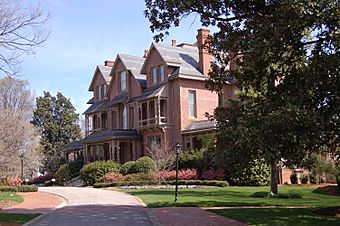North Carolina Executive Mansion facts for kids
Quick facts for kids |
|
|
North Carolina Executive Mansion
|
|
 |
|
| Location | 210 N. Blount St., Raleigh, North Carolina |
|---|---|
| Area | 9 acres (3.6 ha) |
| Built | 1883-1891 |
| Architect | Sloan, Samuel; Bauer, Gustavus Adolphus |
| Architectural style | Queen Anne; Stick/Eastlake |
| NRHP reference No. | 70000475 |
| Added to NRHP | February 26, 1970 |
The North Carolina Executive Mansion is the official home for the Governor of North Carolina and their family. It's also called the North Carolina Governor's Mansion. Building this special house started in 1883. It was designed by two architects, Samuel Sloan and A.G. Bauer. The first family to live there was Governor Daniel G. Fowle and his family. They moved in during January 1891, even though the building wasn't quite finished yet. The mansion is a great example of Queen Anne style architecture.
Contents
Building the Governor's Home
The city of Raleigh had a plan for where the governor's house should be. They first thought about Burke Square. But that spot was already being used by the Raleigh Academy. So, a different place was chosen for the new mansion.
Starting Construction in 1883
In 1883, Governor Jarvis helped pass a law. This law allowed the state to build the third official governor's home in Raleigh. It also made sure the new house would have furniture. The law said the governor had to live in this new home.
Using Local Materials and Labor
To build the mansion, the state used prison labor. This meant people in prison helped with the construction. They also used building materials that could be made at the local prison. This helped save money.
Meet the Architects
Samuel Sloan from Philadelphia and his helper, Aldophus Gustavus Bauer, were chosen as the architects. Sloan came to Raleigh in April 1883 with his plans. Work on the mansion began in the early summer. Sloan passed away in 1885, before the house was finished. Bauer then took over the project. He stayed in North Carolina and became a very important architect in the state.
Materials from North Carolina
The bricks for the mansion were made from clay found in Wake County. Prison workers molded these bricks. You can still see the names of the men who made them on many bricks, especially in the sidewalks. The sandstone trim came from Anson County. The marble steps, which are now on the north side, came from Cherokee County. Strong oak and heart pine wood were shipped from all over North Carolina to build the house.
Changes Over Time
Since it was first built in 1882, the outside of the mansion hasn't changed much. Some porches on the north and east sides have been closed in. This was done to make the kitchen bigger and to add more security.
Updates to the Mansion's Style
During Governor Angus W. McLean's time, the mansion got a new look. It was changed to a Neoclassical style. Many older Victorian features were updated or removed. For example, some woodwork was painted. Stained glass, fancy railings, and mirrors above fireplaces were taken out. Columns were also replaced.
First Ladies' Contributions
First Lady Alice Willson Broughton helped add a service elevator to the house. During World War II, she also started a "victory garden" on the lawn. This garden helped grow food during the war.
Jeanelle C. Moore, who was the wife of Governor Dan K. Moore, started a project. She wanted people to know how important the mansion was. Because of her efforts, the Executive Mansion Fine Arts Committee was formed. This group helps get gifts, buy things, and keep the mansion in good shape.
In 1970, the mansion was added to the National Register of Historic Places. This means it's a very important historical building. In 1974 and 1975, the mansion had a big update. Its plumbing, heating, air conditioning, and electrical systems were all fixed. These projects were very important to keep the building preserved and in use.
Supporting the Mansion's Future
In 1988, a group called the Executive Mansion Fund Inc. was created. This non-profit group helps raise money to restore and preserve the mansion. They ask for donations and manage these funds. Their "Second Century" campaign raised $2 million. The fund also created the "Friends of the Executive Mansion." This group of people and companies supports the mansion with yearly donations.
Governor's Western Residence
North Carolina also has a second home for the governor. It's located at 45 Patton Mountain Road near Asheville. The Asheville Chamber of Commerce gave this home to the state in 1964. They hoped that governors would spend more time in western North Carolina. The home was built in 1939 by Tom Brimer, who owned Good Humor Ice Cream. This 6,000-square-foot (560 m2) mansion sits on 18 acres (73,000 m2) of land.



